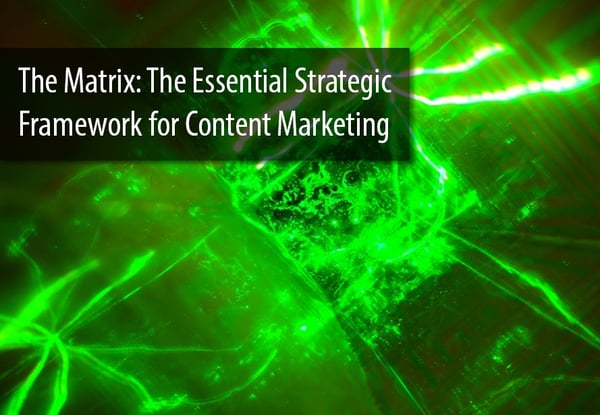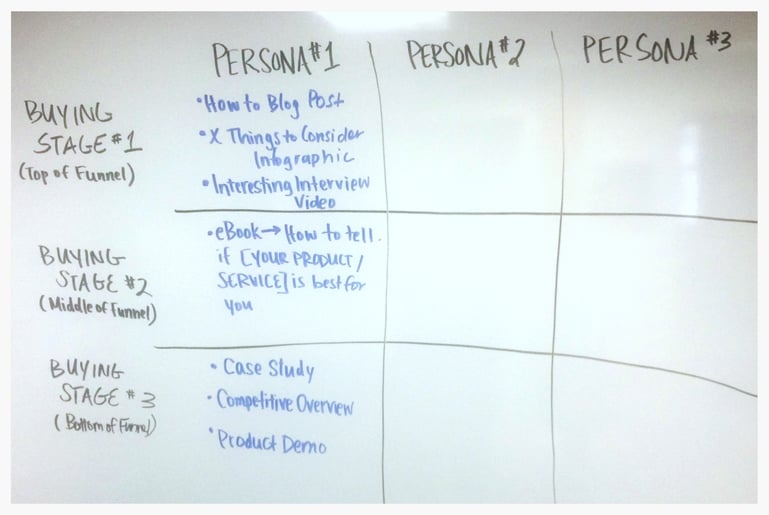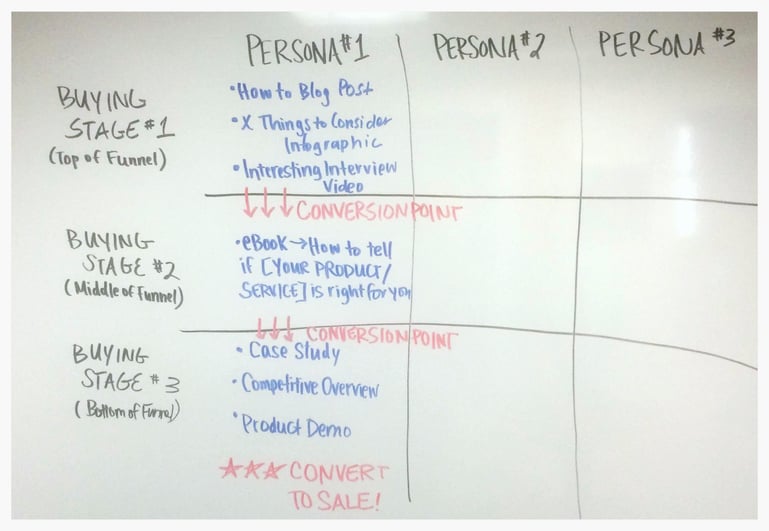
A few years ago, when I was new to content marketing, I learned about a ‘stupid simple’ (in a good way) idea that changed the way I think about content strategy. Mike Lemire, a HubSpot consultant and all-around A+ guy, was helping me come up with ideas. I’d been blogging for awhile and had a lot of content to work with, but none of it was really working.
That’s when Mike introduced me to the content matrix and changed my life forever...or at least changed how I do my job. But really, it was a major “a-ha” moment that has helped me create content that actually converts leads ever since.
The content matrix is a very simple organizational chart that visually depicts the content prospects consume throughout their buying process.
It’s a helpful tool if you’re creating your first content marketing strategy or if you’ve been blogging or creating other content and not seeing strong business results.
Here’s how to create your very own matrix:1. Do buyer persona research.
If you don’t already have defined buyer personas, you’re going to need them in order to create an effective content strategy. Learn more about how to develop persona profiles here and here.
2. Identify steps in your buyer’s journey.
Once someone has visited your site, what makes them a marketing qualified lead (MQL)? What makes them a sales qualified lead (SQL)? Are there one million steps in between? (Hopefully not.) Identify the steps in your buyer’s journey so you can figure out what content will nurture your buyer to the next stages.
3. Create a chart.
This could be done using a spreadsheet like Google Sheets or Microsoft Excel, or it could be chicken scratchings on a whiteboard. I like to map out my thoughts on a whiteboard before creating a more detailed spreadsheet version (see examples below - sorry about the sketchy photography!). You should have your buyer personas along the ‘x’ axis and your buying stages along the ‘y’ axis.
4. For each square of the matrix, brainstorm what content could motivate prospects to take the next step.
If you already have content created, fill in existing assets. If you’re new to content creation, think of this as pure ideation. Imagine what buyers are thinking about in each stage of their journey and what content might answer their questions, solve their problems, make them laugh, etc. Make a list of ideas/assets in each square. Here's what starting a matrix might look like:

5. Develop conversion points.
It’s more than likely that buyers won’t progress down the “funnel” or through your buying process unless you help them along. That’s where it’s useful to develop conversion pathways such as calls to action, landing pages and forms, and nurturing emails and workflows. When you understand what each of your personas is thinking as they consume more and more of your content, you can personalize their experience in order to nurture them to buy.

6. Look for any gaps.
If you’re new to content marketing, you’re starting from scratch. It might take awhile to create the content and conversion pathways necessary to nurture each persona throughout their journey. Start by prioritizing your highest-opportunity personas and building content funnels for one at a time.
If you’ve already started developing content, you’re probably going to notice some gaps in your matrix. Maybe you have mostly decision stage content. Maybe you have only “attract” stage content. Whatever the case, you can use the matrix as a tool to fill these gaps and make your nurturing efforts more effective.
7. Get to work!
Once you have your matrix in place, you’re able to visualize your buyer’s journey and fill any gaps that may be compromising your funnel’s effectiveness. Now the hard part begins - you’ll have to start writing the blog posts and developing the content offers and conversion pathways that will translate this strategy into business results.
The matrix is a great way of simplifying complicated marketing journey/content jargon and boiling it down into a simple, visual map to content success. That said, the matrix doesn’t necessarily help you account for other, more specific aspects of your marketing and content such as influencer outreach, SEO, indirect buying channels, social media promotion, and more.
If you have questions about how to add content marketing to your business’ marketing mix, I’d love to strategize (geek out) with you. Leave a comment below and let me know if you’d like to chat!
Image by danielle_blue via flickr, licensed under CC by-SA 2.0
Share this
You May Also Like
These Related Stories

How Can I Make Myself Invaluable as a Marketing Manager?

Finding Time for Marketing (and Making the Best Use of It)


/Accreditations/CRM-Implementation-Accredited-Badges.png?width=170&height=138&name=CRM-Implementation-Accredited-Badges.png)
/Accreditations/Onboarding-Accredited-Badges.png?width=170&height=137&name=Onboarding-Accredited-Badges.png)
/Accreditations/Custom-Integration-Accredited-Badges.png?width=170&height=137&name=Custom-Integration-Accredited-Badges.png)

